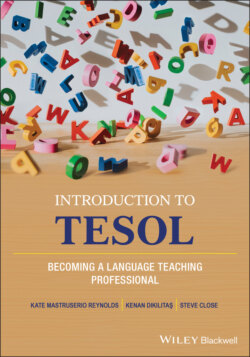Читать книгу Introduction to TESOL - Kate Reynolds - Страница 29
Teaching
ОглавлениеSpecialists may have teaching roles in public or private elementary, middle, and high schools, as well as community colleges and universities in second and foreign language contexts. Educators tend to specialize in an age group or subject matter. For example, an educator may focus on young learners who are learning to read in their primary language while learning to speak, listen, and read in English. At high school, an educator may teach world history bilingually. University-level TESOL educators may work with international exchange students who seek language development or academic degrees or those who were born in an English-speaking country and need support in reading and writing in academics. Others may focus on adult immigrant or refugee learners at a community college who need English for survival in their new culture. Survival English focuses on basic communication skills such as language for interacting when shopping, banking, renting/buying lodging, or securing employment, for instance.
Specialists teach different sizes and styles of classes: one-on-one, small-size classes of 6–20, medium classes of 25–30 students, or large classes of up to 50 in some settings. Some TESOL educators are “floating teachers,” who travel from school to school in a district to provide English language instruction. Some TESOL educators work exclusively online providing one-on-one instruction via distance education. TESOL educators may teach in English immersion, sheltered content, or bilingual classes.
Specialists may work for businesses with corporate language courses for employees or at private language schools. A huge, international corporation with headquarters in Cincinnati, Ohio, offers employees from their international locations intensive courses to enhance their English communication, so employees can collaborate better. Private language schools are privately owned companies that can range in size from small to large corporations. A private language school in Arequipa, Peru, teaches teens and adults oral English for use in their academic and professional lives.
To teach at public K–12 schools in many contexts, professionals need to hold a bachelor’s degree and a teaching license, certification, or other credential appropriate to the country. Depending on the setting, there may be other requirements. To teach English at community colleges and universities, the minimum credential is not a teaching license or certification, but a Master’s degree in TESOL.
To teach online, at private language schools, or in international corporations, the minimum credential varies. For the most part, individuals will need a bachelor’s degree and possibly a Certificate in Teaching English to Speakers of Other Languages (CELTA) or TEFL certificate. The CELTA certificate is a short-duration, intensive teacher preparation credential offered mainly in the United Kingdom and the European Union (EU). The CELTA certificate is widely respected in the field and yields highly capable instructors.
A TEFL certificate is typically granted by private companies, language schools, or universities. These certificates are valued internationally by hiring committees seeking instructors for private language schools. Individuals often confuse the TEFL certificate with a teaching license or teaching certification for a U.S. state.
Generally, individuals earn a TEFL certificate in a short-duration program in person or online. In this case, short-duration can mean 30–60 hr of instruction, but it can be as much as 180 hr. However, if the TEFL certificate is granted by a university, it is often for much more time and higher quality coursework. As a rule of thumb, the quality of teacher preparation is in direct correlation to the number of hours and the quality of the program. As consumers, individuals must make choices as to program duration, quality, and reputation that will help them develop in the profession.
